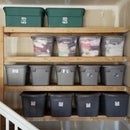Introduction: Fix Your Kenmore Fridge, Cheap!!
Summary
In this instructable I will discuss fundamental principals of all refrigerators (the refrigeration cycle,) walk through simple steps to diagnose the problems, and how to fix your Kenmore refrigerator for cheap.
Though this may seem like an overly simplified instruction, this particular repair was very easy. Being my first time fixing a refrigerator, I was surprised at how little work/skills were needed. So don't feel intimidated. Anyone who is organized and mindful of the process can do this type of project!
Time to Complete:
This repair takes approximately 1.5 hours to complete.
**Warning**
Always use safety gear and avoid dangerous behavior. Always unplug all electronics before working on them.
Step 1: Some Background
The Refrigeration Cycle
Basically every refrigerator operates the same way:
- A gas (refrigerant) is compressed by a compressor.
- The refrigerant then moves through the condenser releasing heat into the surrounding environment (outside the fridge.) As heat is given off the refrigerant condensates into a liquid.
- The refrigerant then passes through an expansion devise (throttle) allowing the liquid to rapidly decompress.
- It then passes through the evaporator where it absorbs heat from the surroundings (inside the fridge.) As heat is pulled back into the refrigerant, it evaporates back into a gas.
- The gas is then returned back to the compressor where the cycle is repeated.
Simply put, when a gas is compressed it "pushes" heat out and when expanded it absorbs heat back in. It's very similar to a pump. That's why this system is also referred to as a "Heat Pump." Heat is literally being pumped from the inside of the fridge to the outside.
Above are 2 photos representing the same thing. The first is a real world application of this cycle. The second is a PV (Pressure/Volume) diagram often used in thermodynamics.
Step 2: Tools You'll Need
To complete this project I utilized a few basic tools.
Tools:
- Multi-meter
- Needle Nose Pliers
- Socket Wrench
- Screwdriver
- "Power Supply"
**Note: the power supply is a direct connect into a 3 prong outlet. This is very dangerous and I highly recommend AGAINST using this type of device. (I'd like to say "I know what I'm doing" but...)
Step 3: Prep Yourself
The owner's manual will have a list of all the parts and give an idea of what to expect if you end up tearing things apart. The manual will also be available online as a PDF in case you've lost it.
Study the diagram to know how the appliance goes together.
The make/model numbers are usually found on the door or just inside the fridge. These are needed to find the owner's manual PDF/order parts.
Step 4: Troubleshooting
To provide some background, the freezer was working just fine but the refrigerator wasn't cooling at all.
Possible reasons for a refrigerator not cooling could be due to:
- Failed Compressor
- Loss of Refrigerant (Leaking out)
- Something else...
Since I could hear the compressor running, and the freezer working just fine, I knew the compressor wasn't the issue. I could also eliminate leaks as an issue since, again, the freezer was working. This left me with "something else..." as the problem.
At this point you just start tearing things apart!!
Step 5: Tearing It Down
After inspecting both the fridge and freezer spaces, the freezer was the only area that had anything looking somewhat "removable."
Pretty much unscrew everything you can find. But be careful of parts that clip together, such as the air tower... These parts aren't quite "Made in the USA" quality.
Keep track of everything. I always take lots of before/after pictures to help remind me of where it all goes.
Step 6: Bingo!
As soon as I removed the back panel and saw this fan I KNEW it was the problem... I'll explain.
The evaporator shown in the photos is the only one in the entire appliance, therefore cool air has to transfer down into the fridge. This fan is the only means of getting cold air into the refrigerator compartment below.
Step 7: Inspection
After taking off the fan assembly I inspected it for any damage and began to pull it apart.
Step 8: Testing 1,2,3... Testing
I recognized the motor specs to be about the same as a standard outlet, 115v 60Hz. Therefore I created a makeshift "power supply" to test if it works. As suspected it didn't. Looking closer I found the problem, a broken wire due to corrosion. I then closed the circuit and tested again just to confirm this was the problem.
I could have soldered this wire back together and called it good but I opted for a new part since it was cheap.
Step 9: New Part
I called Sears repair with the part number from the owner's manual and they were able to provide me with an alternative part number. With this info I was able to search online and found a new motor on Amazon.com for $19 + free shipping.
*Note: You might have noticed the voltage is 120v on the new motor rather than 115v of the old one. My research found that if it's within +/- 5% it should be okay.
Step 10: Reassemble the Assembly
The photos above show the parts of the fan assembly coming back together.
Step 11: Testing the New Motor
Just to be sure, I used the "power supply" to test the new motor.
Step 12: Putting It All Back Together
Hopefully you've kept track of all the parts and wiring! But from here on out you just need to put the fan, back panel, air tower, and floor back into place.
Step 13: You're Done!!
Thanks for reading this instructable! Hopefully you found this to be clear and helpful in fixing your Kenmore refrigerator. If you enjoyed this please feel free to follow me and vote!!






